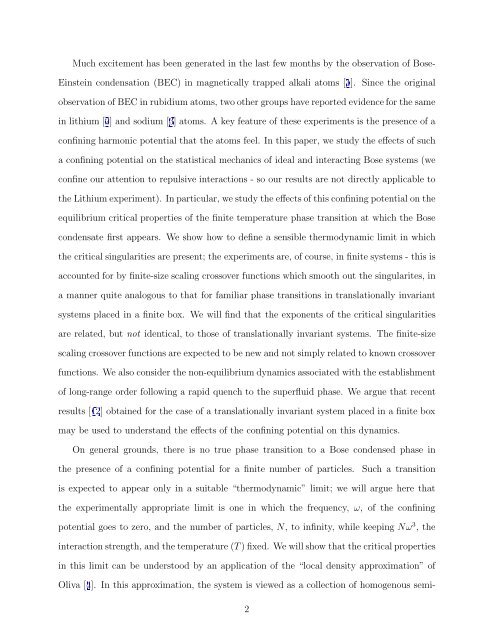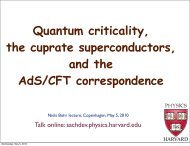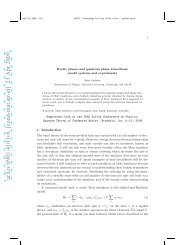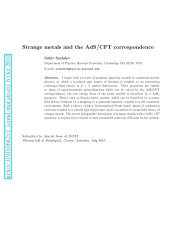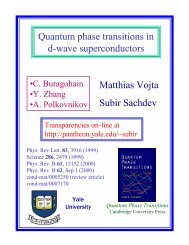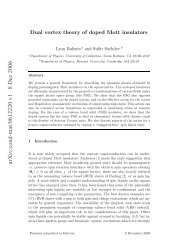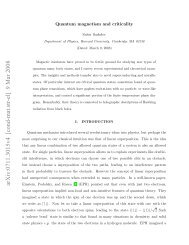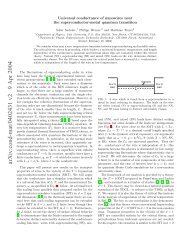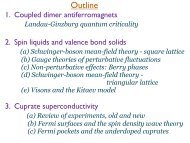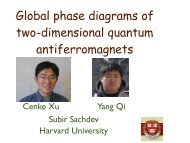Phase transition of a Bose gas in a harmonic potential
Phase transition of a Bose gas in a harmonic potential
Phase transition of a Bose gas in a harmonic potential
Create successful ePaper yourself
Turn your PDF publications into a flip-book with our unique Google optimized e-Paper software.
Much excitement has been generated <strong>in</strong> the last few months by the observation <strong>of</strong> <strong>Bose</strong>-E<strong>in</strong>ste<strong>in</strong> condensation (BEC) <strong>in</strong> magnetically trapped alkali atoms [1]. S<strong>in</strong>ce the orig<strong>in</strong>alobservation <strong>of</strong> BEC <strong>in</strong> rubidium atoms, two other groups have reported evidence for the same<strong>in</strong> lithium [2] and sodium [3] atoms. A key feature <strong>of</strong> these experiments is the presence <strong>of</strong> aconf<strong>in</strong><strong>in</strong>g <strong>harmonic</strong> <strong>potential</strong> that the atoms feel. In this paper, we study the effects <strong>of</strong> sucha conf<strong>in</strong><strong>in</strong>g <strong>potential</strong> on the statistical mechanics <strong>of</strong> ideal and <strong>in</strong>teract<strong>in</strong>g <strong>Bose</strong> systems (weconf<strong>in</strong>e our attention to repulsive <strong>in</strong>teractions - so our results are not directly applicable tothe Lithium experiment). In particular, we study the effects <strong>of</strong> this conf<strong>in</strong><strong>in</strong>g <strong>potential</strong> on theequilibrium critical properties <strong>of</strong> the f<strong>in</strong>ite temperature phase <strong>transition</strong> at which the <strong>Bose</strong>condensate first appears. We show how to def<strong>in</strong>e a sensible thermodynamic limit <strong>in</strong> whichthe critical s<strong>in</strong>gularities are present; the experiments are, <strong>of</strong> course, <strong>in</strong> f<strong>in</strong>ite systems - this isaccounted for by f<strong>in</strong>ite-size scal<strong>in</strong>g crossover functions which smooth out the s<strong>in</strong>gularites, <strong>in</strong>a manner quite analogous to that for familiar phase <strong>transition</strong>s <strong>in</strong> translationally <strong>in</strong>variantsystems placed <strong>in</strong> a f<strong>in</strong>ite box. We will f<strong>in</strong>d that the exponents <strong>of</strong> the critical s<strong>in</strong>gularitiesare related, but not identical, to those <strong>of</strong> translationally <strong>in</strong>variant systems. The f<strong>in</strong>ite-sizescal<strong>in</strong>g crossover functions are expected to be new and not simply related to known crossoverfunctions. We also consider the non-equilibrium dynamics associated with the establishment<strong>of</strong> long-range order follow<strong>in</strong>g a rapid quench to the superfluid phase. We argue that recentresults [12] obta<strong>in</strong>ed for the case <strong>of</strong> a translationally <strong>in</strong>variant system placed <strong>in</strong> a f<strong>in</strong>ite boxmay be used to understand the effects <strong>of</strong> the conf<strong>in</strong><strong>in</strong>g <strong>potential</strong> on this dynamics.On general grounds, there is no true phase <strong>transition</strong> to a <strong>Bose</strong> condensed phase <strong>in</strong>the presence <strong>of</strong> a conf<strong>in</strong><strong>in</strong>g <strong>potential</strong> for a f<strong>in</strong>ite number <strong>of</strong> particles.Such a <strong>transition</strong>is expected to appear only <strong>in</strong> a suitable “thermodynamic” limit; we will argue here thatthe experimentally appropriate limit is one <strong>in</strong> which the frequency, ω, <strong>of</strong> the conf<strong>in</strong><strong>in</strong>g<strong>potential</strong> goes to zero, and the number <strong>of</strong> particles, N, to <strong>in</strong>f<strong>in</strong>ity, while keep<strong>in</strong>g Nω 3 ,the<strong>in</strong>teraction strength, and the temperature (T ) fixed. We will show that the critical properties<strong>in</strong> this limit can be understood by an application <strong>of</strong> the “local density approximation” <strong>of</strong>Oliva [4]. In this approximation, the system is viewed as a collection <strong>of</strong> homogenous semi-2


